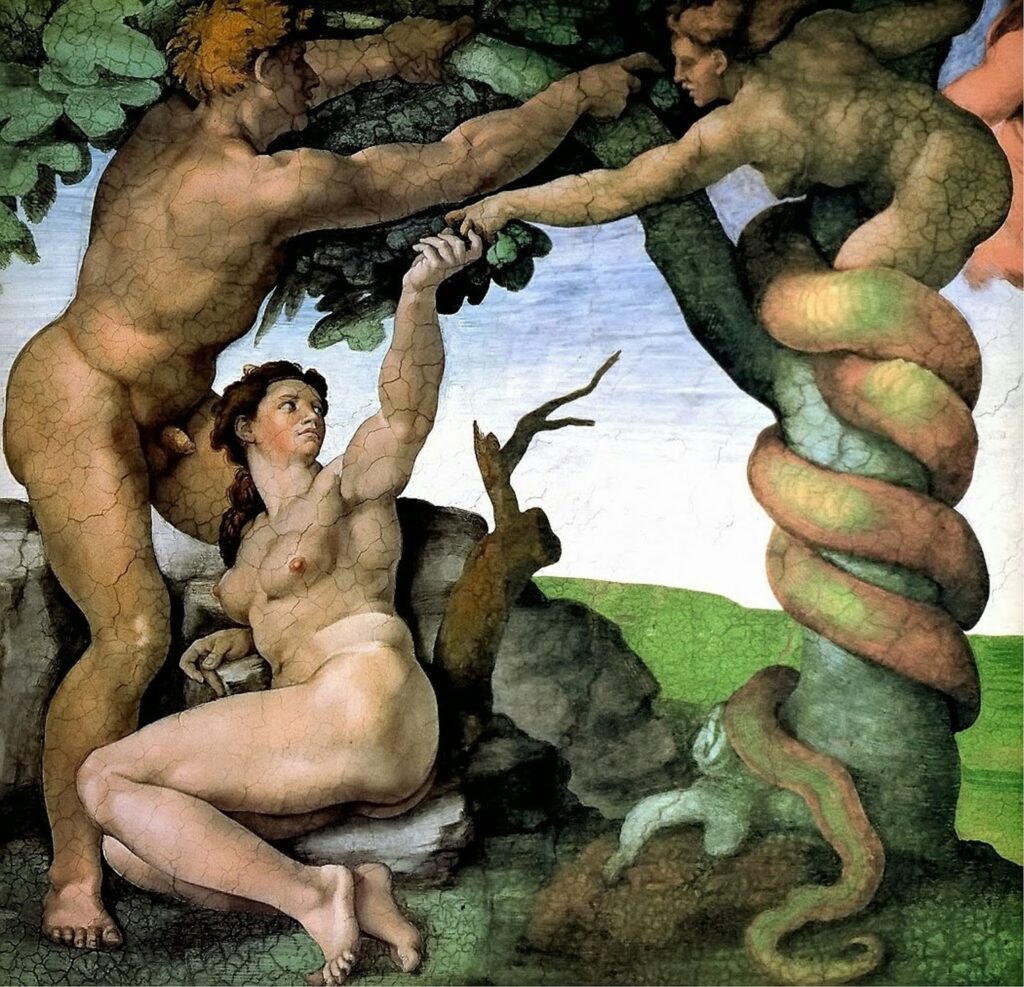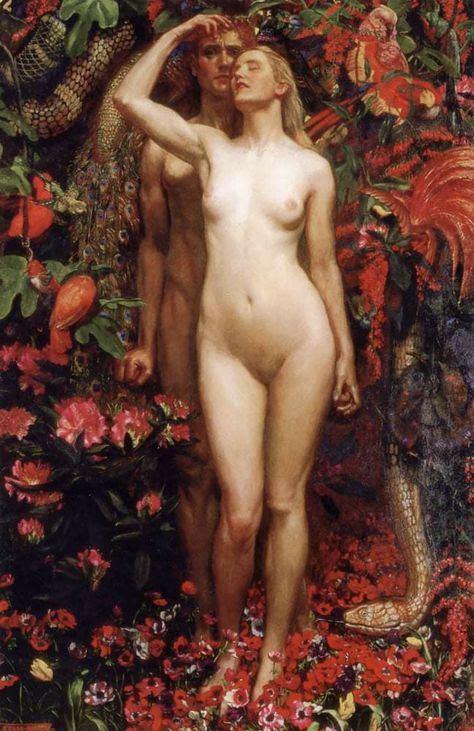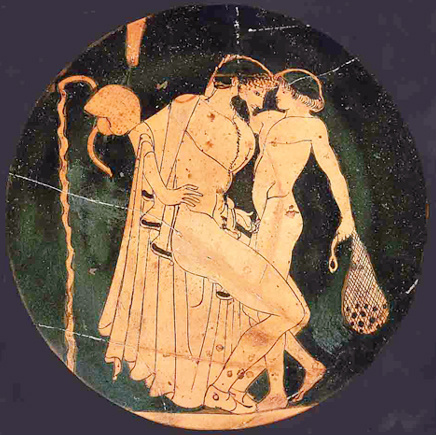Question: Whether it is contraceptives, abortions, divorce, re-marriage, same-sex relationships, etc., the Catholic Church, and religions generally, seem obsessed about sex, and seek to exert control over believers in the most intimate of human relationships. My question is simple: why is the Church so obsessed about sex?
Frank answers: Your question is simple, but it’s not so simple to answer. I think the answer lies in the potent combination of the mystery of human sexuality, the nature of being human, and the way we have constructed societies historically. Only after we’ve looked at these issues can we discuss the religious investment in human sexuality.
The Biology of Human Sexuality
Long before Christianity, before Judaism, even before the Old Testament was written, humanity was already “obsessed with sex.” I think that’s because the sex act is needed for procreation, and procreation is needed for the survival of the human race. Sexual desires are among the strongest urges we experience (called libido). From puberty on, as our bodies become “sexually mature,” the drive to copulate hits us all. The extra bonus is that it is also pleasurable. Our bodies have developed in such a way that the sex act also gives us a good feeling.
Moreover, our brains create emotional bonds between couples engaging in sex, making the possible outcome of child-rearing more likely to be shared between two people. That’s also good for the children. Biologically, human beings have been successful as a species because we can give birth not just once or twice a year, but any time of the year. Males have sperm from puberty through old age and females have twelve different times during the year during which to become pregnant. And since the sex act is pleasurable, we seek it out at all times.

Human Sexuality and Society
Once we move past the basics of biology, past the reasons for humanity’s sexual successes, human society comes into play. Sex is more than an intimate relationship between a man and a woman. It has social consequences. As self-aware and sentient beings, we are able to plan for and create our own futures. We are social animals and as we build our communities we need to be able to get along with one another. This applies especially to a man and a woman practicing coitus with the possibility of begetting offspring and being partners in the raising of children.
Anthropologists believe that human beings evolved in egalitarian groups of hunters/gatherers that shared food, child care, and, often, sexual partners. Once human beings started growing what they ate in one place rather than chasing after it, family life and stability became more important. Families were needed to work together in farming. Men looked for a mate who could be a helper in cultivating the land and producing offspring who could carry on the family business.
Sometimes men took multiple mates. In the Bible (Old Testament) the patriarchs and kings had multiple wives. The twelve sons of Jacob (a.k.a. Israel), who were the patriarchs of the twelve tribes of Israel, were the offspring of two wives and two serving girls. But there was a development toward monogamy that was codified in Judaism and affirmed in Christianity. Islam in the Middle East and Africa continues to sanction polygamy. Mormons once practiced polygamy, but the official branch no longer does.

King Solomon and a few of his many wives
Many people today think that absolute monogamy is humanly impossible. Western societies have legislated against polygamy. But In the Western world today we are seeing experiments with polyamory – men and women living together in one household and sharing sexual partners. Many who divorce practice serial monogamy by marrying more than once. Many practice adultery within marriage by having extra-marital affairs. The reality is that marriage, like every human cultural institution, is fallen. No marriage is perfect. We idolize those couples who manage to remain together and remain reasonably happy fifty years or more.
I want to respond to our marital situation in two ways. First, it is possible to love more than one person. Indeed, I should hope so! We have sometimes had love affairs before settling on a spouse. In marriage vows lovers pledge fidelity to their partner. They do not have sex with anyone else, not because they can’t love anyone else, but because dealing with our one spouse is the way we learn to truly love another person – in sickness and in health, for better and for worse, as we say in the marriage vows. As married couples we together love others – certainly our children and our other relatives (including our in-laws), but also the people who cross our path in our communities and churches. We are given many people to love! One might say that learning to love our spouse through all the ups and downs of married life is practice for loving others.

The Fall Into Sin
At some premordial point sin entered the picture and our relationships with God and one another was no longer what it ought to be. Theology refers to this as “the fall.” This is usually understood as a fall away from God, but it was also a falling away from each other. Adam and Eve didn’t stick together in their collusion to disobey God’s restrictions on eating from the Tree of the Knowledge of Good and Evil. They played the blaming game. Relations between men and women are strained. But if things get too far out of hand, we can mess up our futures and undermine the stability of our societies.

In Michelangelo’s painting of the Garden of Eden on the ceiling of the Sistine Chapel, it looks like Adam and Eve and Lilith the serpent are equally culpable.
We fail in love many times. But as followers of Jesus we are taught to confess our failures and receive forgiveness of sins. In our fallen state we live in and by God’s grace, not by legal casuistries – including the casuistries of church law. Church authorities can be just like the Pharisees in their legalisms. Church law held that the union of two becoming one flesh cannot be annulled. The only annulment that is possible is when a marriage has not been sexually consummated, when there has been no conjugal union. Fictions about this should be avoided. The issue is whether a difficult marriage can be dissolved by divorce. The Catholic Church has said “no;” the Protestant reformers made provision for divorce under some circumstances.
Protecting Marriage through Law
At some point in human history, it was realized that a good way to control people’s untoward behavior was through rules, and if the rules of a society were aimed at our deepest needs and desires, then the rules would be much more successful. You can see this in the Ten Commandments, which deal with our relationships with God, our spouses, our families, and our neighbors.
Since society depends on sex for procreation and producing a family depends on a relationship between a man and a woman, many rules developed to govern the simple act of copulation. I couldn’t even begin to list all the ways in which societies have governed sex acts. But some of the most common concern containing coitus within marriage, not having sex with immediate family members (incest), not having sex with minors (age of consent), and not forcing someone to have sex (rape).
The Traditional Role of Religion
Religion has played a big role in this because the deepest human mysteries—love, sex, and death—are regarded as being bound up with divinity. Mythologies down through the ages and across different societies speak to the divine-human relationships in these mysteries. The clergy caste—shamans, seers, priests, prophets, etc.—became the ones who sanctified and therefore regulated sexual activity. We who live within the modern Western world in the wake of the sexual revolution might be inclined to think that they regulated it more for ill than for good. And since Western society has been formed by Christianity, which the secularized West seems to be trying to be rid of as quickly as possible, the “bad” aspects of religion are laid on Christianity, especially the Catholic Church.
But over against this we ought to consider that while marriages have been and continue to be arranged by parents in most societies in the world, Christian societies have promoted a consensual relationship between would-be husbands and wives, although this often created a tug-of-war between the Church and families. The Church has often served as a peacemaker and sought to bring reconciliation between warring families to preserve peace in civil society (See Friar Lawrence’s role in Shakespeare’s Romeo and Juliet, in which he tried to reconcile the Capulets and the Montagues through the marriage of the star-crossed lovers.)

Marital Mutuality
In the narrative we have come to accept, patriarchy, bolstered by the priestly caste, became the cultural norm, catering to the wants and needs of men first, with women being a secondary consideration. In fact, in the Old Testament women were seen as commodities (property) and this governed many laws regulating sex. At its best the Christian marital relationship reflected the mutuality St. Paul encouraged in his Letter to the Ephesians, in which he compared the relationship of husband and wife to the relationship between Christ and his bride, the Church (which he called a “great mystery” or sacrament). Hence, “Wives, be subject to your husbands as you are to the Lord. For the husband is the head of the wife just as Christ is the head of the church, the body of which he is the savior…. Husbands, love your wives, just as Christ loved the church and gave himself up for her… In the same way, husbands should love their wives as they do their own bodies. For he who loves his wife loves himself.” In sum, “each of you should love his wife as himself, and a wife should respect her husband” (Ephesians 5:22-33).

However, even in Christianity with its love ethic, women were regarded as the weaker sex who depended on the men for protection (the ethic of chivalry). On the other hand, men still had to watch out for the feminine wiles. Didn’t Eve succumb to the serpent’s seductions and eat the forbidden fruit, and then persuade Adam to have some too?

This mythological story at the beginning of the Bible serves to explain why sexual relationships have become so difficult, and why societies have felt that sex has to be controlled. According to this primordial story, sex is tied in with sin. Didn’t Adam and Eve make aprons of fig leaves to cover their loins after they ate the forbidden fruit and realized that they were both naked? In other words, they covered their sex organs. Uncovered genitals didn’t seem to be an issue before they disobeyed God’s word. Sin became associated with sex. So any sexual act apart from the creation of children was regarded as sinful and shameful. Jesus accepted the divine institution of marriage “in the beginning” and also extolled celibacy for the kingdom of God as a high calling. But St. Paul admitted that it’s better to marry than to burn with uncontrolled passion.

Sexual Desire
This created a tension between celibacy and marriage. The ancient church regarded celibacy as a higher vocation than marriage and virginity a higher spirituality than parenting. Augustine of Hippo, who exerted a great influence on Western Christian theology and sexual ethics, discerned that while procreation through coitus is naturally required, desire (libido or concupiscence) isn’t. The fact that desire leads to and accompanies the sex act is the mark of our fallen nature. Desire isn’t even something we can control; it wells up within us involuntarily.

But desire isn’t an outward act; it’s an inner disposition. Medieval catechisms taught that the true purpose of the sex act is procreation within marriage, and desire that accompanies it has to be accepted. The use of desire to promote procreation can even be a good thing. But desire expressed and acted upon apart from this purpose is a venial sin and needs to be confessed. This served to make juridical what is an inner disposition. The confessional examined “the inward thoughts of the heart.” Jesus had taught that “everyone who looks at a woman with lust has already committed adultery with her in his heart” (Matthew 5:28).
The Protestant reformers reacted to this whole development and privileged marriage and family (for which sex is a good and necessary thing) over virginity and religious vows of celibacy. The Catholic Church since the Reformation has also promoted marriage and (large) families. But the ban on contraceptives in the Catholic Church, as reinforced in Pope Paul VI’s encyclical Humana vitae (1968), has really been a fire wall against the separation of sex from procreation that birth control technology made possible.
The Sexual Revolution
People have not considered all the ramifications of the revolution in sexual relationships that birth control actually unleashed. If sex could be separated from procreation (and the “risk” of pregnancy mitigated by taking the birth control pill), sex outside of and especially before marriage became more of an option. The Bible says nothing about pre-marital sex. Birth control encouraged cohabitation, and then having children without getting married—an arrangement one of the unwed partners (usually the male) could more easily walk away from than a marital spouse. In our hook-up culture sex became a form of recreation rather than an expression of a deep connection between men and women. This has been especially the case with teens and young adults. Traditional societies held that sex, marriage, and family required a certain level of maturity.

Today we affirm that sex is not only completely natural, but also that it provides the benefits of physical and mental health. Christian doctrine has also always affirmed that God’s creation is good and that human sexuality is good. The “fall into sin” does not mar that basic affirmation. The sex act itself cannot be considered sinful and the shame associated with some sexual activities in the past, even between husband and wife, needs to be reconsidered. Even some Catholic moral theologians have considered that oral or anal sex can be accepted in marriage as foreplay. But the sex act, in the Catholic view, must still be aimed at procreation. Also, sex should be a pleasurable act for both partners.

That said, we need to recognize that the modern sexual revolution that would separate sex from procreation and liberate human sexuality from all previous moral restraints flies in the face of the collective wisdom of human social history. Unrestrained sexual expressions and any-which-way relationships are finally not good for our common life. Ironically, the legalization of same-sex marriage is a conservative recognition of the need for restraints and mutual commitments.

Same-Sex Desire
How do we account for same-sex desire has become a major issue in society and religion? Some Protestant churches have become more welcoming of gays and lesbians, including a willingness to officiate at same-sex marriages. We have come to realize that we don’t have definitive answers as to why some men and women are sexually attracted to persons of the same sex. Is it biologically rooted or caused by life experiences? Is there any sexuality that is not based in both biological inheritance and social/cultural expectations? Gay people uniformly report that they did not choose to be homosexual. They came to recognize that this is who they are. They are attracted to persons of the same sex. Psychiatry has determined that homosexuality is not a mental disorder. It remains a part of the mystery of sexuality. Religion, culture, social mores, and politics have striven to suppress it. But even if people who are gay or lesbian remain “in the closet” or try to suppress their desires, they realize down deep their own sexual orientation. Homosexuality is found in every society in the world. It is practiced in the animal kingdom, especially among the higher primates. How do we account for that in human sexuality? What role do gay people play in society? We should note that terms like “sexual orientation” or even “homosexuality” and “heterosexuality” come out of modern social science and were not concepts known in earlier times.

Perhaps the acceptance of homosexuality expands our understanding of the purpose of sex. It has been and continues to be about procreation. But it is also about establishing an intimate bond between two people and the means by which they express love for each other. Certainly this is a way in which heterosexual couples have approached love and sex. Homosexuals may also have something to teach opposite-sex couples about attraction to another, a desire to touch the other and become sexually aroused, and come to orgasm through mutual stimulation just for the pleasure of it and not only for procreation.
Sexuality On a Sliding Scale
We need to affirm some fundamental norms, such as the biological givenness of the human body and the complementarity of male and female for procreation. We also need to make space for those whose sexual orientations and gender identities don’t fit these norms, as many societies and culture have historically done. Western societies are increasingly allowing this space precisely because sex is a deeper mystery than we can completely understand. The famous Kinsey Report, for example, found that total opposite-sex and total same-sex attractions are opposite extremes along a continuum in which men and women are more or less attracted to the opposite or same sex.
Albert Kinsey’s data came from in-depth, face-to-face interviews (with 5300 white males and 5940 white females providing almost all of the data).
Sexual Behavior in the Human Male (1948) and Sexual Behavior in the Human Female (1953) reported that:
- 37% of males and 13% of females had at least some overt homosexual experience leading to orgasm;
- 10% of males were more or less exclusively homosexual and 8% of males were exclusively homosexual for at least three years between the ages of 16 and 55. For females, Kinsey reported a range of 2-6% for more or less exclusively homosexual experience/response.
- 4% of males and 1-3% of females had been exclusively homosexual after the onset of adolescence up to the time of the interview.
- Kinsey devised a classification scheme to measure sexual orientation. It is commonly known as the Kinsey Scale.
- There has subsequently been refinement of Kinsey’s studies to account for variations in sexual orientation based on age, education, and class. Young college educated males are more likely to have had homosexual experiences than older, middle class men without a college degree.
Many societies in human history made provision for men to mentor older boys and initiate them into sex and adult society, after which they were ready to marry and raise a family, and perhaps mentor a youth in turn. This is obviously not an arrangement modern Western societies are willing or able to embrace, but we recognizes that it was practiced by pre-Christian Greek, Roman, Celtic, Viking, and Teutonic warrior cultures.

There were Greek philosophers and Roman Stoics who discouraged the pursuit of man-boy relationships. To what extent were Christians influenced by Platonic and Stoic views that were current in the first centuries AD? Why did there continue to be some tolerance among Christians for same-sex love in antiquity? Why did all hell break out against sodomites in the late Middle Ages? To what extent did defining homosexuality as a state of being in modern clinical sexology contribute to modern homophobia in which men have to prove that they are not gay by lashing out against homosexuals? These are important questions that require discussion.
Family Life
As for family life, there are some realities for which we have data. Children whose parents biologically produced them and who sealed their relationship with the public commitment of marriage have a better chance at life, especially at getting out of poverty, than those who lack this loving support. Pope Francis is not wrong to bring together two of his biggest concerns: addressing the needs of the poor and stabilizing families.

The population decline in the Western world and East Asia is directly caused by less sex between males and females and fewer babies being produced. Men and women date less often and wait until they are well established in a career before they even think of getting married and raising a family. Marriage is becoming a “luxury good” that only financially stable couples can afford.
The social isolation of the COVID-19 pandemic offered fewer opportunities for men and women to get together in person and develop relationships. College counsellors report that some students don’t even know how to develop relationships. Many college graduates have computer-using jobs that enable them to work from home. They resist going to the office where they might meet someone of the opposite sex in the flesh. They depend on dating aps which, like the pornography they often watch, gives them a false understanding of human sexuality and sexual relationships. Sociologists have spoken of a “sexual recession” in the amount of sexual contact the current young adult generation has in comparison with what previous generations had at their age. The kind of sex most frequently practiced by young adults is solo and virtual, both of which were encouraged by health agencies during the pandemic instead of sex that required bodily contact. We need to recover human touch in both sex and worship. (See Frank Answers About Recovering Connections and Touch.)

Virtual sex is not real sex.
The New Role of Religion
The role of religion today is not to regulate sex, as it once did (and still does in much of the rest of the world — and not only Christianity!), but to affirm basic sexual norms while making space for those whose orientations are exceptions to the rule. About the latter Pope Francis said, “Who am I to judge?” He’s actually referring to St. Paul’s words in Romans, which follow the apostles’ words about women and men exchanging natural sexual relations for unnatural (that is, customary sexual positions) and other evil and foolish practices, “you have no excuse, whoever you are; for in passing judgment on another you condemn yourself, because you, the judge, are doing the very same things” (Romans 2:1)
But about the family, the pope said on his visit to Cuba, “Without family, without the warmth of home, life grows empty, there is a weakening of the networks which sustain us in adversity, nurture us in daily living and motivate us to build a better future.” He added that despite the “many difficulties that afflict our families, families are not a problem, they are first and foremost an opportunity. An opportunity which we must care for, protect and support.”
The pope’s title “Pontifex maximus” comes from the pagan Roman high priest. It means “greatest bridge builder.” Pope Francis has said that the Church must be a bridge, not a roadblock, for the faithful. The traditional teachings serve to protect and promote the fundamental norms of human sexuality that we see in human biology, in social structures, in culture, and in the biblical revelation of the Creator’s intention for human sexuality. But we are also aware that human sexuality transcends biology, social structures, and cultural habits, and that we often read our cultural views into the Bible without regard for its textual and cultural context.

Sex is a mystery that reflects the mystery of God. Holiness can be discovered in the flesh, not apart from it, for “the Word became flesh and dwelt among us, full of grace and truth” (John 1:14). We will therefore apprehend God’s grace and truth for humanity in the flesh. Faith communities must bless the marriage bed and pastorally accompany their members as they discern and celebrate their essential sexuality.
Pastor Frank Senn






